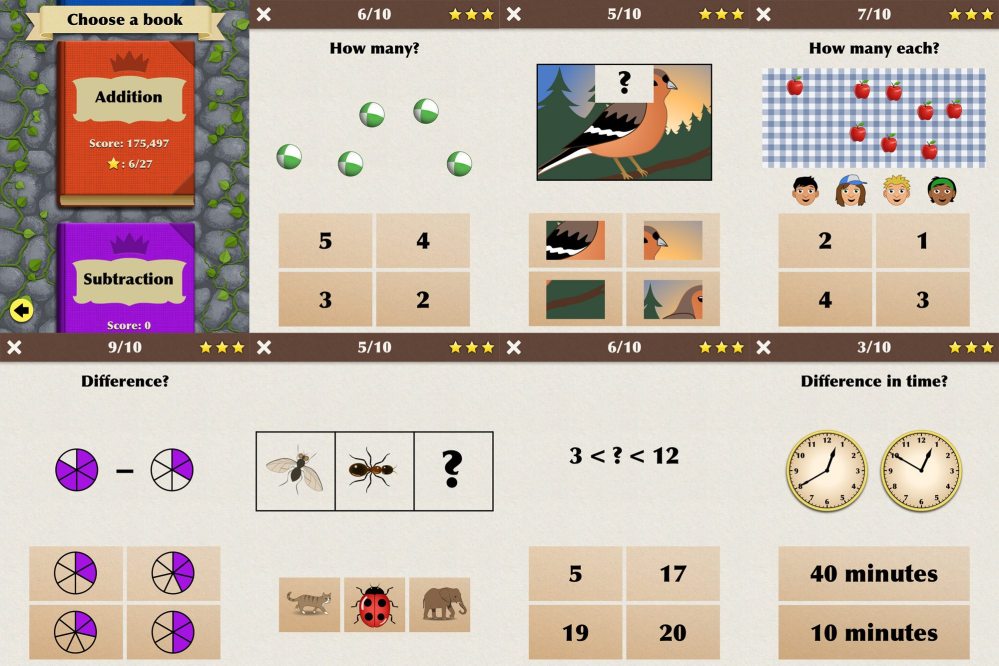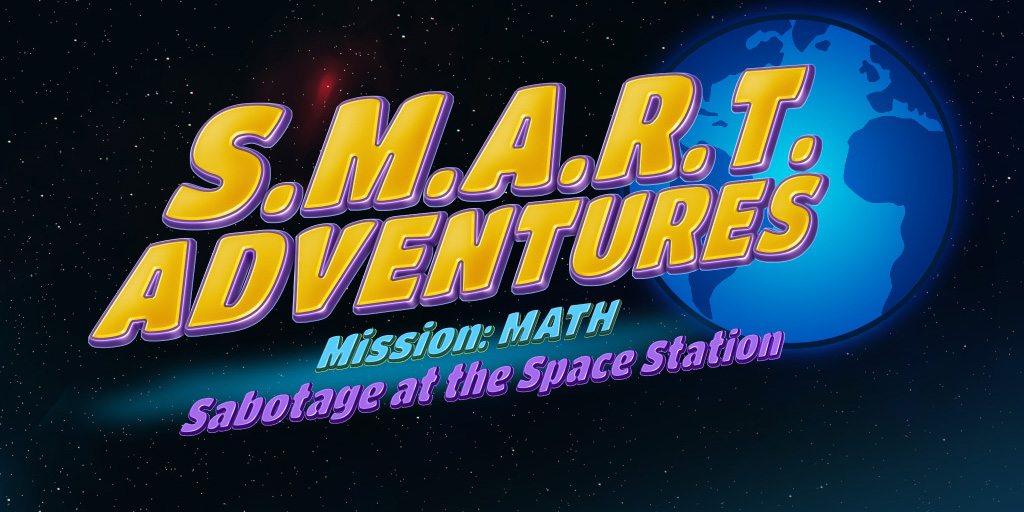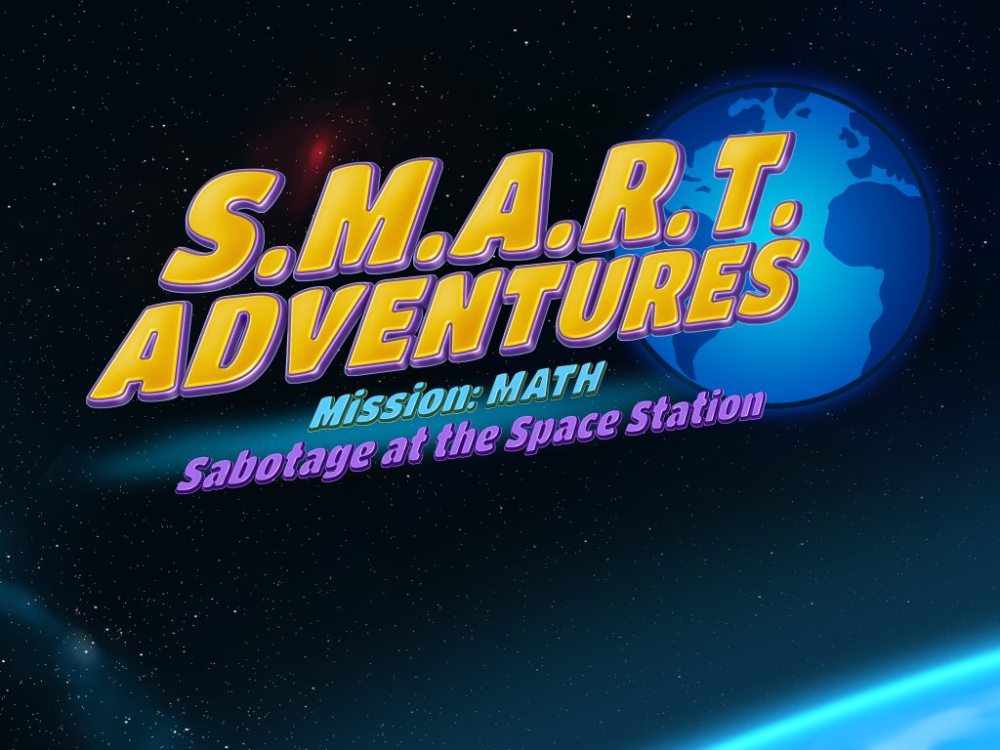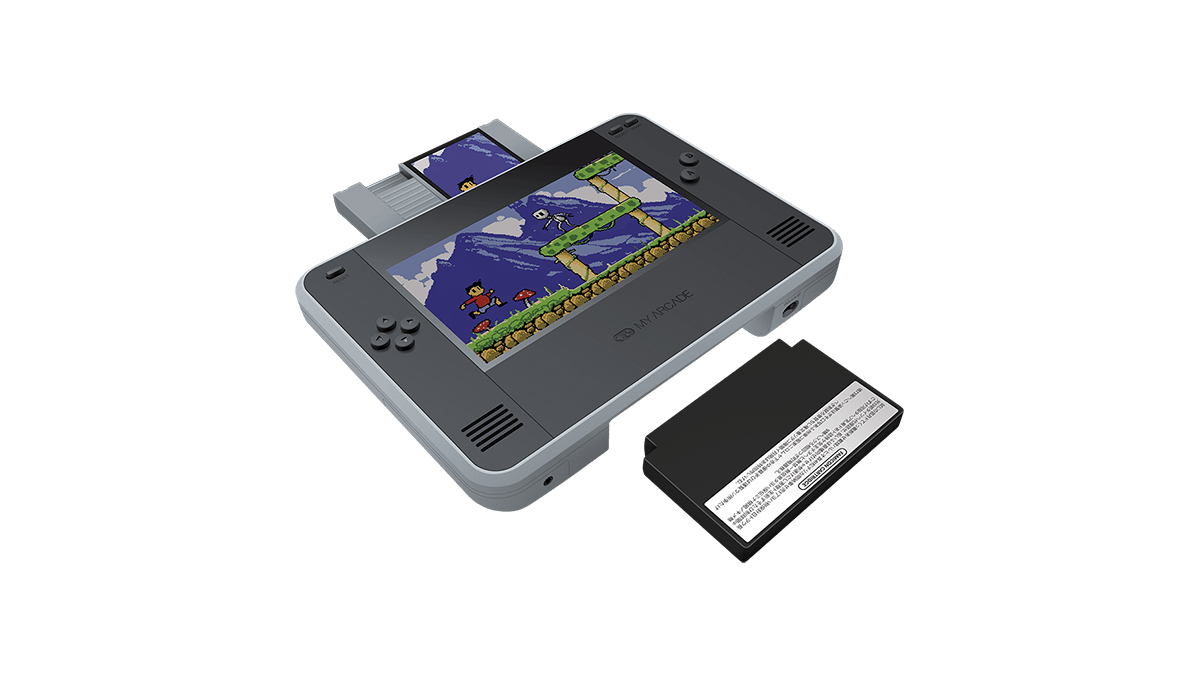It’s been a while since I’ve written up any iOS apps, but that doesn’t mean I haven’t been playing them. This summer I’ve been trying to keep my daughters’ math skills sharp—particularly the older one, who had been slipping a little during the school year. But between the new baby and summer activities I’ve been a bit occupied and I haven’t had the ability to sit down and play card games or just do math drills. So as a stopgap measure I’ve been using a few math apps on the iPad.
My kids get screen time tokens that they can spend as they choose—watching cartoons on Netflix, playing games online, or playing on my iPad. During the school year, the main requirements were that they had to be done with any homework and violin practice before spending a token. For the summer, we added one more: before they got to use a 20-minute token to play, they had to spend ten minutes playing something math-related first. Since I’ve got a number of math-based apps to choose from, they didn’t mind at all—particularly because it was an extra ten minutes of screen time.
Here are three of the apps that they’ve been playing with. I’ve checked them out myself and while they may vary in efficacy, these are at least the ones that they’ll choose to play.

We’ll start with the simplest one: King of Math Junior. The app is intended for ages 6 and up. (There’s also King of Math which covers middle school/junior high level math, but we’re not quite there yet.) The app allows for several profiles, so each kid has their own records of how they’re doing. I can tell at a glance how many points they’ve earned—plus, as you get points, you level up, which the kids enjoy. (There are boy and girl versions of the various characters, which is also pretty nice.)

The problems are arranged in books, starting with basic counting and arithmetic skills, moving to geometry, comparisons, and fractions. There are also some puzzles and measuring problems. Each book has nine chapters in increasing difficulty, and you can earn from one to three stars in each chapter.
The problems are presented with very simple language, and they’re just multiple choice—tap on the right button to move on to the next problem. You’re rated on both your accuracy and speed, so there is some implicit encouragement to repeat chapters until you get all three stars.
Overall I’d say the problems included aren’t extremely difficult, but I like the variety of ways that problems are presented. Rather than just asking “What is 5 x 4?” the app may show four jars with five tomatoes each, and ask how many tomatoes there are. It gives the kids different concepts related to the arithmetic they’re doing.
One odd thing is that you can reach the highest level (King and Queen, naturally) without 3-starring all of the chapters. There are still more medals to win which do involve completing the chapters, but I wonder if my kids will lose interest once they hit Queen even if they haven’t finished everything.
Both King of Math and King of Math Junior are for iPad or iPhone, and have free versions if you want to try them out first, but at $.99 each they won’t break the bank.

The next one in complexity is Mission: Math—Sabotage at the Space Station. This one looks like a point-and-click adventure, although there’s not really a lot of interaction aside from moving from room to room and solving problems. The story is about a young S.M.A.R.T. agent who’s on her first routine mission, and you’re the junior agent who’s tagging along. But when the space station is sabotaged, you’re called upon to help figure out who did it. You get to adjust the look of the agent; I’m told the game is geared toward providing positive role models for girls—the young agent is a woman and there’s also an older woman who shows up later—but the junior agent can be made to look like a boy or a girl.
The math covered in the game is intended for ages 9 and up, and should match what students know by the end of fourth grade, which is perfect for my oldest daughter. Each room of the space station has one particular type of math problem. The simplest one involves simply pointing out the right place in a digit (ones, tens, hundreds, tenths, hundredths, etc.). There are also problems that involve fractions, simple geometry, and factors.

The “chemistry lab” problems are more about measuring: making sure you have the right beaker, and then measuring the right amounts of fluids and powder to create goofy recipes. There’s also one lab in which you do math in Chinese, sort of: you’re presented with various math problems, but the answer choices are written out in pinyin, with a chart to consult.
As you solve problems, you get little snippets of storyline, and eventually the culprit is revealed. There isn’t really any interactivity during these cut-scenes, though, and your avatar isn’t animated like the rest of the characters. And although they do try to make your math problems part of solving various issues on the space station, some of the tasks seem, well, nonessential. It is fun, though, to have the little videoscreen while you’re learning problems—there are some other junior agents who get on the line with you and talk about what’s going on.
My daughter played through the entire app, and immediately asked if we could get the next one, which is teased at the end—but I had to tell her it’s not actually available yet, since this one is still a relatively new game. So she’s started over, even though she already knows the storyline. You can create multiple profiles in Mission: Math, so if you’ve got more than one kid playing through it the app will track their progress separately.
Overall, I was impressed with this one, mostly in the way that it held my daughter’s attention, and for presenting some interesting ways to present math problems. The graphics and interface can be a little clunky at times, but my kids didn’t seem to mind. At $7.99, it is a bit pricier, but if you’ve got kids at the right age range it could be worth it.
DragonBox is still one of the most amazing educational apps I’ve encountered. It’s an app that teaches the mechanics of solving algebraic equations (“solve for x“) in a truly innovative way. When we first tried it out last year, my daughters were 8 and 5, and both of them were solving simple equations within an hour of playing with the app.
This year the publisher released DragonBox 2, which is very similar but covers more advanced topics, like parentheses, addition of fractions with common denominators, and more. The actual names in the iTunes store are DragonBox Algebra 5+ and DragonBox Algebra 12+, for the recommended ages.

Basically the way the app works is that you have two “trays” on the screen with little icons on them that look like creatures. At least one of them is a little sparkling crate, and you want to isolate that on one tray. The app ramps up gradually, showing you how to drag icons around, cancel out positive and negative versions of the icons, multiply or divide both sides of the equations by something, and so on.
The most fascinating thing to me was that it actually requires no arithmetic skills at first. It’s simply learning the rules to this game. But then, as the little creatures eventually get replaced by letters and numbers, the player becomes aware that the rules to DragonBox are the same as the rules of algebra. The app does not teach the theory of solving equations, just the mechanics of it, but what it does is internalize the habits. I don’t think that it should replace standard algebra teaching altogether, because you’ll need somebody to explain why the equations balance by doing these operations. But as far as teaching somebody how to solve an equation, I’m not sure I’ve ever seen anything that makes it so fun.
The older version is $5.99 and the newer version is $9.99. I don’t think you necessarily need to get both—the second one starts fresh and includes twice as many chapters. The app also allows for multiple players, each with their own account (and little cartoony avatar). Players are rewarded with a little growing creature as they solve problems, plus the usual one to three stars depending on how well you solved the equation.
Well, there you have it! These aren’t all of the math apps I have on my iPad. For instance, Operation Math is another one that GeekDad Jim Kelly recommended which is mostly about drilling arithmetic problems more and more quickly, but has a secret agent theme. My daughter could probably use that sort of practice, but she hasn’t been as excited about it. And I know Numbers League is another one that GeekMom Jenny Williams loves, both in digital form and the card form.
For now, though, these three are holding my kids’ interest, and when school starts I guess we’ll see how well they retained their math skills over the summer!
[This post originally ran in August, 2013]







Awesome. Exactly what I’ve been looking for
Great post! Have your kids played the Tic Tac Math games on the App Store in iTunes? They’re much different than the apps that you write about here, they are quick to play, familiar and function more like sugar-coated flash cards for math facts or a fun way to engage with fractions and algebra for the more advanced topics.
Thanks for another great set of reviews. I look forward to sharing these with the boys. They routinely pick coolmath.com for their screen time, so I’m pretty sure they’ll be interested.
Thanks for sharing your experience with us(Worth for reading). I heard DragonBox is a great app for kids, i haven’t tried yet but you explain it very effectively. I am using Splash Math, it is a very cool app for kids (K-5) currently they have launched their web version at http://www.splashmath.com. I personally like this web solution because it gives us a feasibility to engage our kids anywhere and in any device.
Even if it is for older kids like mine (13, 14 and 17) I think you forgot a great one there:
I stumbled upon it looking for a way to help my kids as a single father who can’t afford a private tutor:
It’s called MATH 42 (https://itunes.apple.com/en/app/math-42/id664457128?mt=8) , and helps them (and me ) to understand and solve a math problem step-by-step, by giving suggestions on how to solve it and defining unknown notions.
It also enables me to check up on them and their progress thanks to the integrated test mode.
Hope I helped,
Charlie
Thanks for the suggestion! My oldest daughter is only 9 so we’re not quite there yet. 🙂
See if they would try out this clean, simple app. Not quite a game, but good practice. https://play.google.com/store/apps/details?id=com.androidtest.austin&hl=en
Great way to learn math with apps. Can try this website to learn http://www.math-children,com
http://www.math-children.com
Thank you for your VERY informative discussion of these math apps. I am looking for another great math app like King of Math for seventh graders. I think that math app is fun and is a great review of the basics. If you come across any more that are of that quality and less expensive than the ones you found please let me know. Thanks again. Anne
Hi Jonathan – Mission Math: Sabotage at the Space Station is running a special summer promo and is now only $4.99! It is also available on Android, Kindle and in Dutch, French,Spanish, Portuguese and German!
Thank you for this great resource!
Mathematics is one of the fundamental subjects for success in school and ,arguably, in life.
Web: http://mathskillbuilder.org – This free site is great and will support your children as they grow into math students.
As a parent, you’ll appreciate the constant feedback and assessment reporting it provides.
If you have an Android devices, use App, it is better that web version
https://play.google.com/store/apps/details?id=com.msb